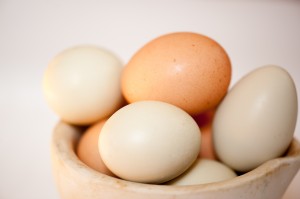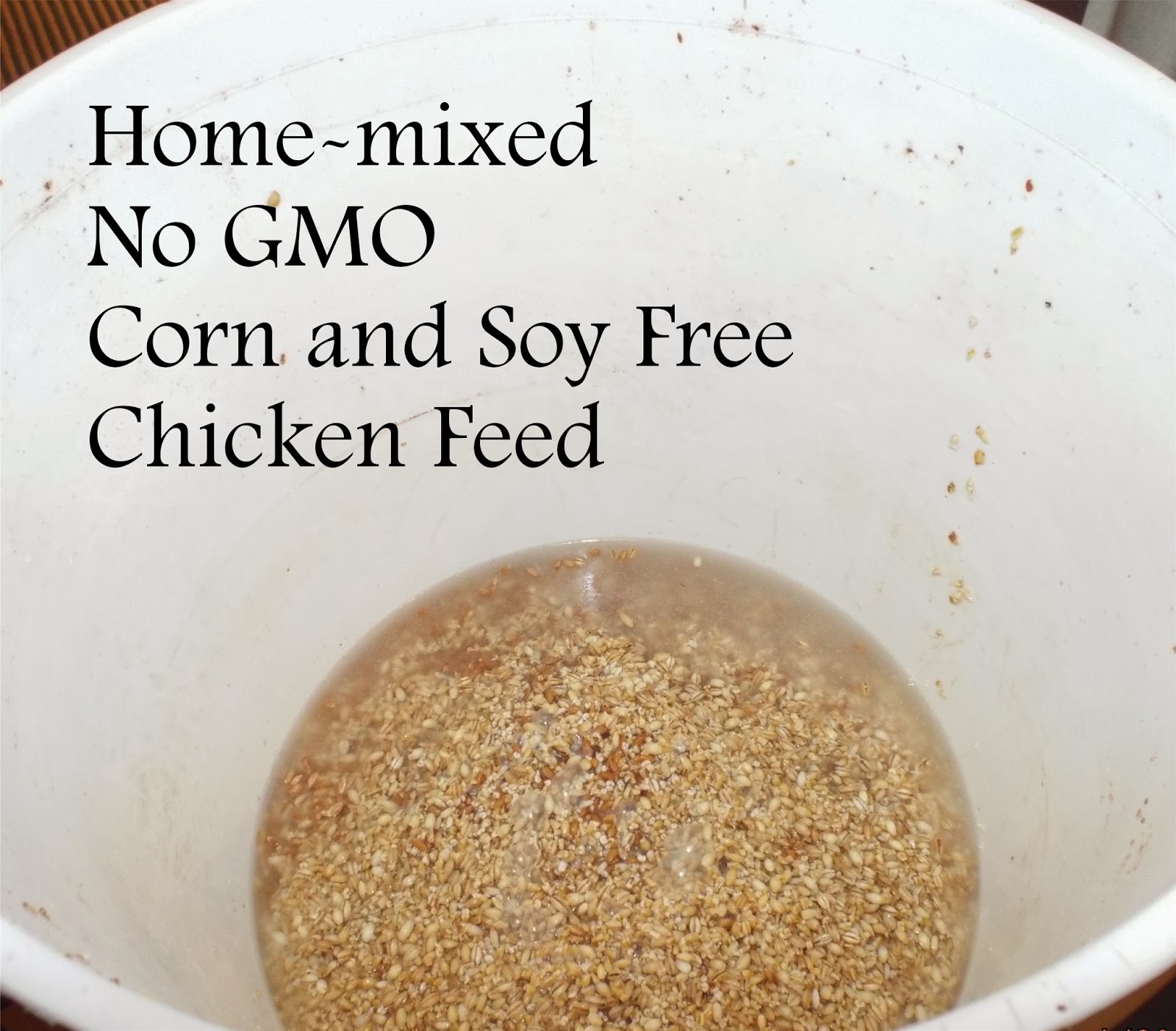I keep seeing posts online for homemade chicken feed, and I always click hopefully on the links, only to find that they all seem to have a dozen different ingredients (that I can't find locally) which would cost about five dollars a pound to mix. I don't know about you, but even considering the importance I put on quality food (that's why I raise my own chickens, after all!) I can't afford that. With my 40-odd bird flock, that would break the bank pretty quick!
So I finally sat down and did a little research into what a basic, simple-to-mix ration needed to have, and came up with the recipe below. I was a little scared to share my recipe right away, in case there was any glaring nutritional deficiency that might show up later (I'd hate to give bad advice and perhaps harm someone's animals!) but I'm happy to report that my girls have been living on this ration for five months now and happily laying that whole time (even through the sub-zero weather we've been getting lately) so I think it's safe to share.
This is still going to be more expensive than the feed from my local Farm & Fleet store (which I believe is still around $13 for a 50-pound bag), and even than the organic feed I was buying (which, last August, was about 43 cents a pound). But that feed relied heavily on soy and corn, both of which make me uncomfortable from a nutritional standpoint. Plus the fact that I had to drive an hour and a half one way to get it (and we always seemed to run out at the busiest times in my schedule!)
So I started making my own. It's important, whenever changing feed for your animals, to make the change gradually, mixing in a little more of the new feed each day, until you phase out the old ration completely. A sudden change of feed isn't good for any animal.
The Cheerful Agrarian's Homemade Chicken Feed
(this makes enough for about 10 hens)
2 cups wheat
1 cup oats or barley (I mix the two, to total 1 cup)
1 cup black oil sunflower seed
1/2 cup flax
2 Tbsp Fertrell Nutribalancer
I like to soak the grains overnight, mixing the wheat, oats, and barley and covering with water (or whey, if I have any left over from
making cheese). This encourages the grains to sprout slightly, which enhances the nutritional content and makes the whole grains easier to digest. In the morning, I add the flax (which I first grind in a coffee grinder - unground flax just goes right through the chickens whole), the Nutribalancer, and the sunflower seeds.
Notes:
I tried soaking the sunflower seeds with the grains, but they tended to get moldy, even if only soaked overnight, so I switched to just adding them in the morning.
I don't buy ground flax because it goes rancid so quickly it would be bad before it picked it off the store shelf. My
cheap little coffee grinder handles the flax seeds just fine.
I add raw apple cider vinegar to the chickens' water each day (about 1 tablespoon per gallon) to boost their immune system (
here's the link to how I make it, or you can use some you've purchased).
They have oyster shell available free choice, and I like to toast eggshells after I've used them and feed them back, crushed, with the other kitchen scraps. I've never had problems with soft shells.
Whenever I think of it, I chop up a clove of garlic and add it to the kitchen scraps, again to boost their immune systems.
Every so often, I quarter a small pie pumpkin and feed it to the girls. It is reported that there are compounds in pumpkin seeds that kill intestinal worms.
I buy my grain in 50-pound bags at the local bulk food store for about 50 cents a pound. I like to get Wheat Montana's Bronze Chief Red Spring Wheat (red wheat has a higher protein content), but if they don't have it I've also used their Prairie Gold White Spring Wheat (which I've also seen for sale at my local Walmart in 25-pound bags, for about the same per-pound price). Wheat Montana guarantees that their wheat is GMO-free and chemical free (not organic, but as close as I can afford right now).
I did some research, and found that there is no GMO version of barley, oats, flax or sunflowers, so that makes my whole mix GMO free (Nutribalancer is certified for use on organic farms).
I buy my flax in 25-pound bags from the same bulk food store where I buy my grains, and it makes the most expensive portion of my mix at over a dollar a pound (but since I use less of it, it doesn't drive up the overall price of the feed too much). The sunflower seed I get from a local farmer for a little over 30 cents a pound.
So this feed costs me a little under 50 cents a pound - which is more than I was paying for the organic feed, but I don't have to drive an hour and a half to get it (gas isn't getting any cheaper, nor is the wear and tear on my truck!) and it doesn't have any corn or soy in it (which I'd prefer not to have, even if it's organic). The biggest perk, though, is that I could one day grow all of this myself (if I scaled way back on the number of chickens I raise and way up on the amount of garden space for growing grain - but still, theoretically, it's possible). In the meantime, I'm looking for more local farmers who would be willing to sell grain directly to me, which I think would be a very happy compromise.
This post is part of the
Sunday Social blog hop.





































